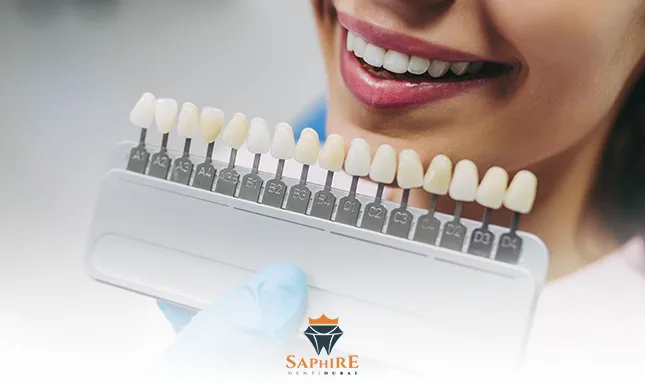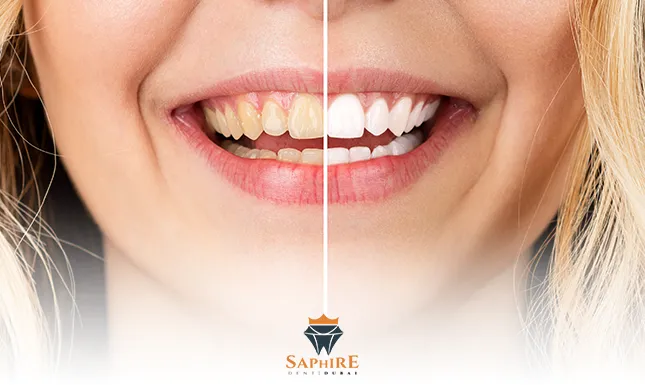Why do we use dental veneers?
the smile is the first beauty language
Teeth play a strong role in the smile, they are the first language of beauty we speak. In a world where beauty and self-confidence are paramount, modern techniques to enhance the appearance of teeth have become commonplace. Among these techniques, dental veneers comes as a popular and effective option for enhancing smile aesthetics.

What are dental veneers?
Thin shells to enhance the appearance of your teeth.
Dental veneers, or tooth veneers, are thin pieces typically made of materials such as porcelain or resin, which are bonded to the front surface of teeth to enhance their appearance. This technique represents one of the latest advancements in cosmetic dentistry and is used to address various dental cosmetic flaws, making it an ideal choice for improving smiles and achieving an attractive appearance.

When is it recommended to use dental veneers?
Dental veneers are considered as an ideal option for enhancing the appearance of the smile in many cases, including:
1.Covering discolorations:
Condition:Presence of discolorations on the teeth that cannot be easily removed by teeth whitening.
Benefits:
- Permanently covering these discolorations and restoring the teeth to their natural color.
- Achieving a bright and clean smile.
- Improving self-confidence and feeling comfortable when smiling and speaking.
2. Improving dental alignment:
Condition: Teeth that are uneven in size or shape.
Benefits:
- Unifying the size and shape of the teeth and enhancing their overall appearance.
- Achieving a harmonious and attractive smile.
- Improving dental functions and enhancing the chewing process.
3.Closing dental gaps:
Condition: Presence of gaps between the teeth affecting the aesthetic appearance
Benefits:
- Permanently closing these gaps without the need for braces or surgical procedures.
- Achieving a complete smile free of gaps.
- Improving oral health by preventing food and bacteria buildup in the gaps.
4.Correcting tooth shape:
Condition: Damaged, chipped, or unevenly shaped teeth.
Benefits:
- Repairing these imperfections and permanently improving the appearance of the teeth.
- Achieving a healthy and beautiful smile.
- Improving dental functions and enhancing the chewing process.
5.Correcting tooth positions:
Condition: Some teeth are protruding or misaligned.
Benefits:
- Improving the position of the teeth and permanently correcting their alignment.
- Achieving a harmonious and attractive smile.
- Improving dental functions and enhancing the chewing process.

What's new in veneers?
With the the technology and progress in the field of cosmetic dentistry, innovation in dental veneers hasn’t stopped. Among the new aspects added to this technique, they can be identified as follows:
1.Digital design techniques:
Utilization of digital design and CAD/CAM technologies:
- It has become possible to design and manufacture dental veneers accurately and custom-fit for each case individually.
- This ensures better consistency and a natural appearance of the teeth.
2. New materials:
New materials have been developed for the manufacturing of dental veneers, providing increased durability, resistance to discoloration, and wear.
These materials include:
- Zirconia: Known for its high strength and fracture resistance.
- Veneer E-max: Renowned for its natural appearance resembling real teeth.
- Composite veneers: Distinguished by their relatively lower cost.
3. New bonding techniques:
New bonding techniques have been developed for attaching dental veneers more effectively and accurately, ensuring their stability and longevity.
These technologies include:
- Resin bonding: A common technique known for its ease of use.
- Cement bonding: A more durable technique resistant to slippage.
4. Increased comfort and fit:
Because of the new technologies and innovative materials, it is possible to install dental veneers more comfortably and conveniently for the patient, reducing the need for painful preparatory procedures and making the installation experience less disruptive.

Steps for installing dental veneers:
The installation of dental veneers consists of specific steps, including:
1. Consultation with the dentist:
- Assessment of the case and determination of whether dental veneers are the optimal choice.
- Discussion of the patient’s expectations and needs.
- Conducting a comprehensive examination of the mouth and teeth.
2. Smile design:
- Taking digital impressions of the teeth.
- Designing dental veneers based on the patient’s needs and expectations.
- Utilizing computer simulation software to display the smile’s appearance after veneer installation.
3. Tooth preparation:
- Removing a thin layer of tooth enamel to ensure the consistency and adhesion of the veneers.
- Ensuring not to damage the tooth nerve.
- Using local anesthetic materials to minimize pain sensation.
4. Final installation:
- – Affixing the veneers onto the teeth using special adhesive materials.
- Ensuring proper and secure attachment of the veneers.
- Making slight adjustments to the veneers as needed.




